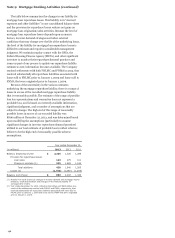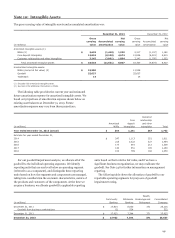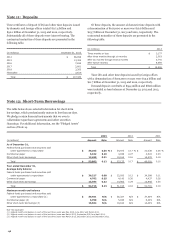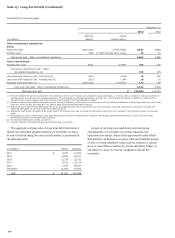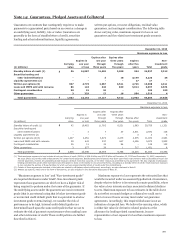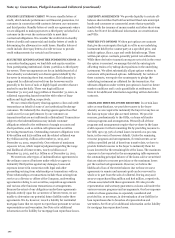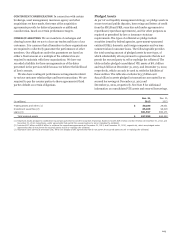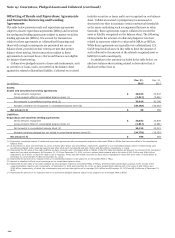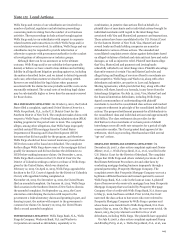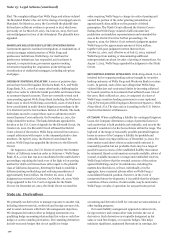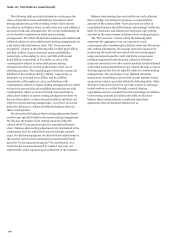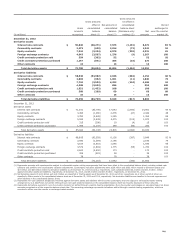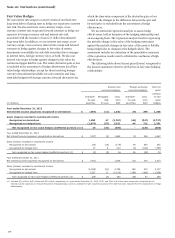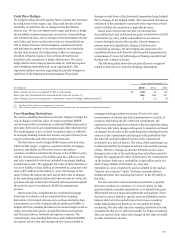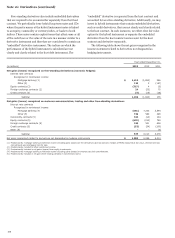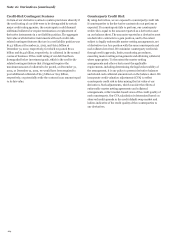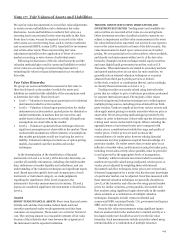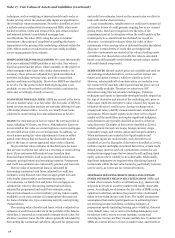Wells Fargo 2013 Annual Report Download - page 208
Download and view the complete annual report
Please find page 208 of the 2013 Wells Fargo annual report below. You can navigate through the pages in the report by either clicking on the pages listed below, or by using the keyword search tool below to find specific information within the annual report.
Note 15: Legal Actions (continued)
filed. The complaint alleges that Wells Fargo and others violated
the Maryland Finder’s Fee Act in the closing of mortgage loans in
Maryland. On March 13, 2013, the Court held the plaintiff class
did not have sufficient evidence to proceed to trial, which was
previously set for March 18, 2013. On June 20, 2013, the Court
entered judgment in favor of the defendants. The plaintiffs have
appealed.
MORTGAGE RELATED REGULATORY INVESTIGATIONS
Government agencies continue investigations or examinations of
certain mortgage related practices of Wells Fargo and
predecessor institutions. Wells Fargo, for itself and for
predecessor institutions, has responded, and continues to
respond, to requests from government agencies seeking
information regarding the origination, underwriting and
securitization of residential mortgages, including sub-prime
mortgages.
ORDER OF POSTING LITIGATION A series of putative class
actions have been filed against Wachovia Bank, N.A. and Wells
Fargo Bank, N.A., as well as many other banks, challenging the
high to low order in which the banks post debit card transactions
to consumer deposit accounts. There are currently several such
cases pending against Wells Fargo Bank (including the Wachovia
Bank cases to which Wells Fargo succeeded), most of which have
been consolidated in multi-district litigation proceedings in the
U.S. District Court for the Southern District of Florida. The bank
defendants moved to compel these cases to arbitration under
recent Supreme Court authority. On November 22, 2011, the
Judge denied the motion. The bank defendants appealed the
decision to the U.S. Court of Appeals for the Eleventh Circuit. On
October 26, 2012, the Eleventh Circuit affirmed the District
Court’s denial of the motion. Wells Fargo renewed its motion to
compel arbitration with respect to the unnamed putative class
members. On April 8, 2013, the District Court denied the
motion. Wells Fargo has appealed the decision to the Eleventh
Circuit.
On August 10, 2010, the U.S. District Court for the Northern
District of California issued an order in Gutierrez v. Wells Fargo
Bank, N.A., a case that was not consolidated in the multi-district
proceedings, enjoining the bank’s use of the high to low posting
method for debit card transactions with respect to the plaintiff
class of California depositors, directing the bank to establish a
different posting methodology and ordering remediation of
approximately $203 million. On October 26, 2010, a final
judgment was entered in Gutierrez. On October 28, 2010, Wells
Fargo appealed to the U.S. Court of Appeals for the Ninth
Circuit. On December 26, 2012, the Ninth Circuit reversed the
order requiring Wells Fargo to change its order of posting and
vacated the portion of the order granting remediation of
approximately $203 million on the grounds of federal
preemption. The Ninth Circuit affirmed the District Court’s
finding that Wells Fargo violated a California state law
prohibition on fraudulent representations and remanded the
case to the District Court for further proceedings. On
August 5, 2013, the District Court entered a judgment against
Wells Fargo in the approximate amount of $203 million,
together with post-judgment interest thereon from
October 25, 2010, and, effective as of July 15, 2013, enjoined
Wells Fargo from making or disseminating additional
misrepresentations about its order of posting of transactions. On
August 7, 2013, Wells Fargo appealed the judgment to the Ninth
Circuit.
SECURITIES LENDING LITIGATION Wells Fargo Bank, N.A. is
involved in five separate pending actions brought by securities
lending customers of Wells Fargo and Wachovia Bank in various
courts. In general, each of the cases alleges that Wells Fargo
violated fiduciary and contractual duties by investing collateral
for loaned securities in investments that suffered losses. One of
the cases, filed on March 27, 2012, is composed of a class of
Wells Fargo securities lending customers in a case captioned
City of Farmington Hills Employees Retirement System v. Wells
Fargo Bank, N.A. The class action is pending in the U.S. District
Court for the District of Minnesota.
OUTLOOK When establishing a liability for contingent litigation
losses, the Company determines a range of potential losses for
each matter that is both probable and estimable, and records the
amount it considers to be the best estimate within the range. The
high end of the range of reasonably possible potential litigation
losses in excess of the Company’s liability for probable and
estimable losses was $951 million as of December 31, 2013. For
these matters and others where an unfavorable outcome is
reasonably possible but not probable, there may be a range of
possible losses in excess of the established liability that cannot
be estimated. Based on information currently available, advice of
counsel, available insurance coverage and established reserves,
Wells Fargo believes that the eventual outcome of the actions
against Wells Fargo and/or its subsidiaries, including the
matters described above, will not, individually or in the
aggregate, have a material adverse effect on Wells Fargo’s
consolidated financial position. However, in the event of
unexpected future developments, it is possible that the ultimate
resolution of those matters, if unfavorable, may be material to
Wells Fargo’s results of operations for any particular period.
Note 16: Derivatives
We primarily use derivatives to manage exposure to market risk,
including interest rate risk, credit risk and foreign currency risk,
and to assist customers with their risk management objectives.
We designate derivatives either as hedging instruments in a
qualifying hedge accounting relationship (fair value or cash flow
hedge) or as free-standing derivatives. Free-standing derivatives
include economic hedges that do not qualify for hedge
accounting and derivatives held for customer accommodation or
other trading purposes.
Our asset/liability management approach to interest rate,
foreign currency and certain other risks includes the use of
derivatives. Such derivatives are typically designated as fair
value or cash flow hedges, or economic hedges. This helps
minimize significant, unplanned fluctuations in earnings, fair
206


